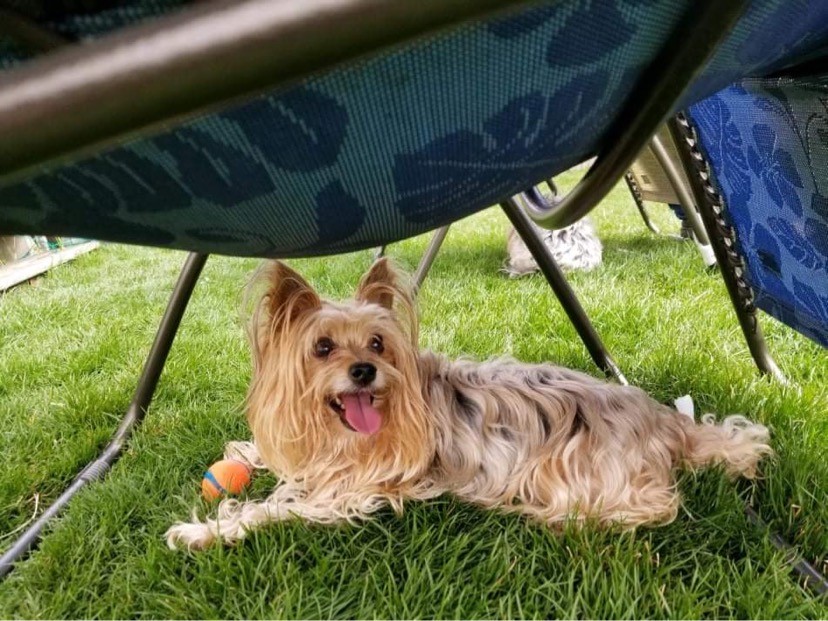-
Are Yorkies Intelligent?
-
What are the major health concerns for Yorkies?
-
Do Yorkies make good family pets?
Continue reading to find out more!

Yorkshire Terrier Basic Breed Information
Name: Yorkshire Terrier
Breed Age: Recognized by the AKC in 1885
Average Size: 7-8”
Average Weight: 7lbs
Life Expectancy: 11-15 years
Coat Variations: Black & Tan, Blue & Gold, Blue & Tan, Black & Gold
Fun Fact: The Yorkshire Terrier was originally used to hunt rodents in places like mines, mills, and farms.
Read more about the Yorkie on the AKC’s website.
Yorkshire Terrier Breed History
As you may have guessed, the Yorkshire Terrier gets its name from the region of England where it originated. During the Industrial Revolution in the mid-1800s, Scottish workers traveled to England looking for work in mines and mills. They brought with them a small dog known as a Broken Haired Scotch Terrier. These dogs were most likely bred with 3 other Terriers to create what we know today as the Yorkshire Terrier. There are no breeder records from this time to confirm, but it is believed that the Scotch Terrier was bred with the Paisley Terrier, the Skye Terrier, and/or the Clydesdale Terrier to create the Yorkie. Workers wanted a small breed of dog that would hunt rats and other rodents, but who wouldn’t take up a lot of space in cramped conditions like mine shafts.
Yorkshire Terrier Strengths
- Yorkshire Terriers are hypoallergenic
- Long life span
- Great watchdogs
- Affectionate
- Little to no shedding
- Playful and adaptable
- Travels well
- Yorkies are intelligent and love to have a “job”

Yorkshire Terrier Weaknesses
- May not be great in a multi-dog household
- Yorkie Temperament: If not socialized, Yorkies can be aggressive towards strangers and other dogs
- May not have a lot of patience for children, especially very young ones
- May be difficult to house train quickly
- Does require almost daily grooming to keep tangles and matted hair manageable
- Can be very vocal
- Requires stimulation, and can be a higher energy breed despite their size
6 Common Yorkshire Terrier Health Concerns:

Dental Health
-
- Unfortunately, dental health is a major concern for most dog breeds. According to research, over 80% of dogs over 3 years old have active dental disease. To prevent advanced dental diseases such as gingivitis and tooth loss, bring your pet in soon for a routine dental cleaning!
Legg-Calve-Perthes
-
- According to the Orthopedic Foundation for Animals (OFA), “Legg-Calve-Perthes Disease (LCP) is a disorder of hip joint conformation occurring in both humans and dogs. LCP results when the blood supply to the femoral head is interrupted resulting in avascular necrosis, or the death of the bone cells. This process of bone cells dying and fracturing followed by new bone growth and remodeling of the femoral head and neck can lead to stiffness and pain.” The OFA also lists Yorkies as being the #1 breed most affected by Legg-Calve-Perthes.
Collapsed Trachea
-
- This is common amongst small dog breeds. It is a progressive condition, so catching it early is essential. Experts generally recommend using a harness for walking rather than a collar to avoid any excess strain on the tracheal rings that support the windpipe.
Liver Shunts
-
- The Yorkie Info Center claims that “Yorkshire Terriers have almost a 36 times greater risk of developing shunts than all other breeds combined.” Liver shunts limit normal blood flow to the liver, forcing the blood to bypass the liver instead of allowing flow in and out. This leads to the build-up of the body’s toxic waste products like ammonia. Less threatening cases may only require a low-protein diet and medications, whereas moderate to extreme cases generally require surgery.
Hypoglycemia
-
- Hypoglycemia refers to a condition that results in rapid drops in blood sugar levels. It is typical with small breeds, and usually with younger puppies. Symptoms can include dizziness, trouble walking, weakness, and confusion. Vets usually recommend feeding smaller meals more frequently throughout the day, rather than 1-2 larger meals to avoid the development or progression of hypoglycemia.
Hyperadrenocorticism (Cushing’s Disease)
-
- Another common issue among dogs, Cushing’s Disease is a disorder that causes the adrenal glands to produce too much steroid hormone. Symptoms usually include excessive drinking and urinating, reduced energy level, increased appetite, hair loss, thin skin, and a potbelly. This disease requires close monitoring by a veterinarian to ensure the correct medications and dosages.
If you have any questions or concerns about your pup’s health, please contact us as soon as possible to address them!
Famous Yorkshire Terriers: Smoky the War Dog

Smoky was a Yorkshire Terrier who was discovered by an American soldier in the New Guinea jungle during WWII. She was sold to Corporal William A. Wynne, who she traveled with throughout the remainder of the war. She even shared rations like Spam with the Corporal. Here are just a few of Smoky’s accomplishments, achievements, and accreditations:
- Smoky Served in the South Pacific with the 5th Air Force, 26th Photo Reconnaissance Squadron and flew 12 air/sea rescue and photo reconnaissance missions.
- Smoky was credited with twelve combat missions and awarded eight battle stars.
- She survived 150 air raids in New Guinea.
- She also survived a typhoon in Okinawa.
- Smoky has even parachuted from 30ft in the air using a custom-made parachute.
- According to an account given by Corporal Wynne, Smoky “saved his life by warning him of incoming shells on an LST (transport ship), calling her an ‘angel from a foxhole’. As their ship’s deck was booming and vibrating from anti-aircraft gunnery, Smoky guided Wynne to duck the fire that hit eight men standing next to them.”
- Smoky helped engineers complete an airbase in Luzon in the Philippines. Smoky’s task was to run a telegraph wire through a 70ft long pipe with an 8inch diameter, though some sections were as small as 4inches in diameter due to soil in the pipe. By tying the wire to her collar and encouraging her to run through the pipe, the task went from a three-day-long digging project to a ‘simple’ minutes-long ordeal. Smoky and her crew saved roughly 250 crewmen and 40 United States fighters from having to fly recon trips and dig in an unsafe location which would have opened them all up to the risk of enemy bombings.
Read more about Smoky’s amazing adventures here.

